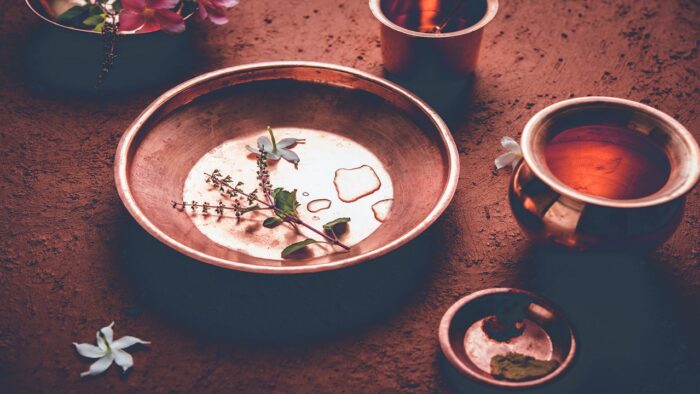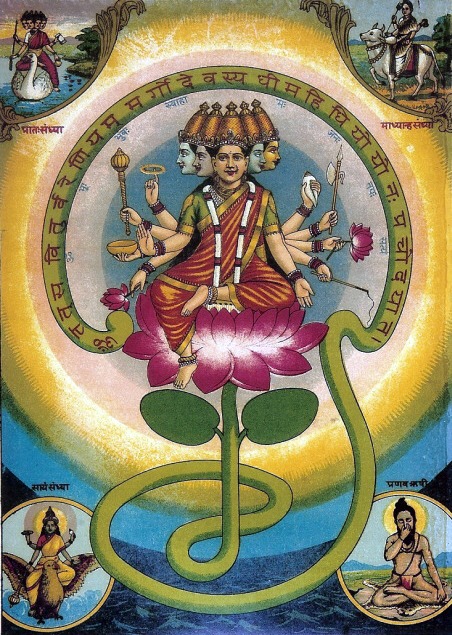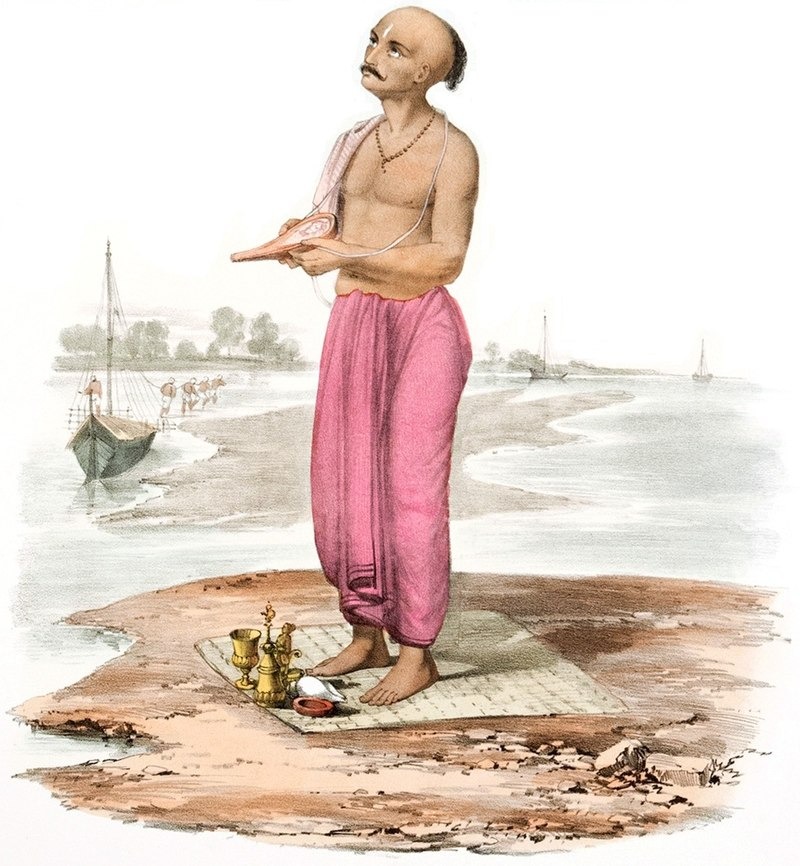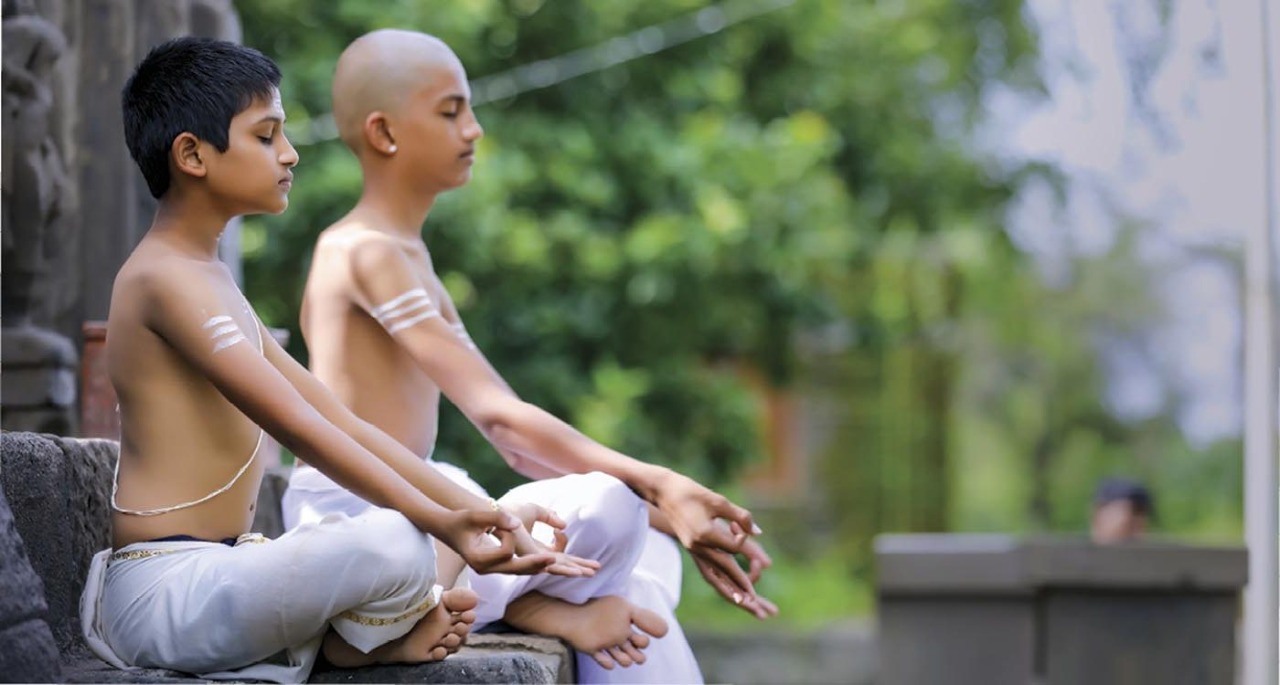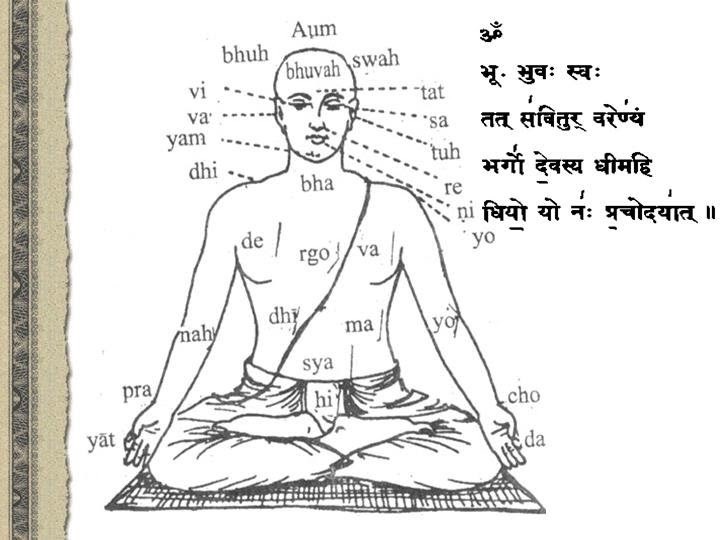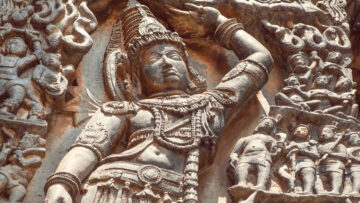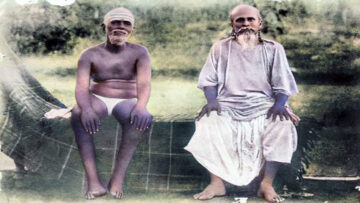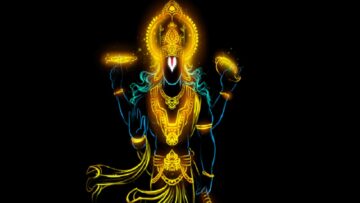Introduction
Prāṇāyāma with accompanying mantra-s features in multiple portions of the sandhyāvandana ritual, most prominently preceding Gāyatrījapa. While versions of sandhyāvandana specific to sects are several, prāṇāyāma has a measure of ubiquity throughout them. In the present day, the foremost association of prāṇāyāma in the popular imagination is with the practice of yoga, where its physical implementation is more elaborate and varied (in forms such as nāḍī-shodhana and bhrāmarī) and its mantra component is minimal or absent. Regardless of whether the ultimate origins of prāṇāyāma lie in the Veda or in the Yoga system, its integration into the vaidika ritual that is the sandhyāvandana can be shown both to be apposite to considerations of Vedānta and compatible with the intent of Yoga texts. There is mutual synergy in how a cycle of practice is established for prāṇāyāma by incorporating it into the daily sandhyā ritual, and in how the meditation-enabling functions of prāṇāyāma are harnessed in the sandhyā ritual into the service of Gāyatrī japa. The template of a yajña is claimed to underlie both sandhyā (in the application of Veda mantra-s and coverage in smṛti texts) and prāṇāyāma (in its casting as an offering to divine beings in Purāṇa and Itihāsa discourses).
As a vaidika ritual, sandhyāvandana is applicable to a wider section of traditionally authorized practitioners than that of vaidika yajña-s. As a yoga practice, prāṇāyāma is applicable to a wider section of practitioners than that of vaidika rituals. The intersection of prāṇāyāma and sandhyāvandana is of interest, for both the potentially less numerous traditional sandhyāvandana ritualists (to better appreciate how their ritual benefits from potencies of prāṇāyāma realized elsewhere too), and the potentially more numerous practitioners of prāṇāyāma in the context of contemporary Yoga, secular meditation, fitness, or therapy (to recognize how a practice familiar and beneficial to them, is acknowledged and accorded a high ritual status in a more formal vaidika setting as well). The primary intent of this study is to present to both groups of practitioners a set of motivating examples for an exploration of their chosen practice’s traditional roots that are exquisitely intertwined in both fundamental texts and longstanding praxis.
The chief mantra elements of sandhyāvandana have a vaidika origin, always in spirit and often in letter as well, and this is true also of the mantra-s assigned for prāṇāyāma in sandhyāvandana. In the ritual grammar of sandhyāvandana, prāṇāyāma can be seen as embodied punctuation, which distinctly renders attention to key ritual units such as saṅkalpa (formal resolution to commence the overall ritual), arghya (consecrated offering of water), japasaṅkalpa (formal resolution to commence mahāmantrajapa), Gāyatrī mahāmantrajapa (mental recitation of the Gāyatrī mantra typically with 108 repetitions) and upasthāna (concluding portion of the ritual performed standing). Of all these occurrences, the one before Gāyatrī mahāmantrajapa is accorded special ritual emphasis through an increased count of repetitions and prefacing with nyāsa, and is the primary focus of study here too. Prāṇāyāma as formulated in Sandhyāvandana combines physical assistance for breathing, mental preparation for mantrajapa, and intellectual inspiration for realizing the contemplative ends of both breathing and mantrajapa beyond their formal accomplishment.
Methods
This paper examines the roles of Prāṇāyāma in Sandhyāvandana in terms of:
- Ritual specifications summarized from Smṛti-s in guides for practitioners
- Compatibility with practice requirements stated in Yoga texts
- Imbuing Aupaniṣada conceptions of Prāṇa and Praṇava into breathing and japa
- Sacrificial symbolism attributed in Purāṇa and Itihāsa discourses
- Ergonomic conduct of the ritual, complementary to theoretical significance
Handbook-like ritual guidance texts pertain directly to sandhyāvandana, but contain minimal philosophical commentary, and are therefore referred here mainly for ritual specifications of prāṇāyāma. Yoga, Vedānta and Purāṇa-Itihāsa texts pertain to actions, concepts and symbols integral to sandhyāvandana even if they do not explicitly mention the ritual, and such texts will be referred here emphasizing connections to ritual elements that are potentially helpful for practitioners. Observations independent of texts on the utility of prāṇāyāma to mantrajapa will also be listed. Considering how fundamental the concepts of Prāṇa and Praṇava are both to Vedānta and Yoga, the survey of literature here is not exhaustive and is meant only to serve as a series of prompts for practitioners to recognize ever more dimensions and connections of their practice during their own reading of the literature.
Review Summary
Smṛti-based guides
Manual specifications (i.e., positioning of fingers) and verbal supplements (i.e., expanded framing of the Sāvitrī with Praṇava, vyahṛti-s and Gāyatrī-śiras) of Prāṇāyāma, that render it assistive to Gāyatrījapa, are found documented consolidating multiple traditional sources in guides like VedāntīSītārāmaśāstrī’s Kṛṣṇayajurvedīya Sandhyāvandana Bhāṣya and Kāśinātha’s Dharmasindhu. The late 18th century text Dharmasindhu devotes a section to Sandhyāprayoga in its third pariccheda on daily rituals. The Kṛṣṇayajurvedīya Sandhyāvandana Bhāṣya (referred to hereonward as Sandhyāvandanabhāṣya) authored by VedāntīSītārāmaśāstrī in the early 20th century is dedicated exclusively to sandhyāvandana and rigorously cites primary smṛti sources for each instruction.
The Dharmasindhu mentions prāṇāyāma as a component of sandhyāvandana shared across śākhā-s. In the Sandhyāvandanabhāṣya, the smṛtikāra-s Manu, Yājñavalkyaand Saṃvarta are quoted defining prāṇāyāma as chanting thrice the Sāvitrīmantra accompanied with Praṇava, vyāhṛti-s, and Gāyatrīśiras by “one who has kept the breath measured” (āyataprāṇaḥ). The state of measured or controlled breathing is in the form of kumbhaka or breath-hold manually assisted by closing the nostrils with the fingers of the right hand, leaving the left hand free for maintaining counts. In particular, the right nostril is to be closed by the thumb and the left nostril by the little and ring fingers. The sequence described in the Dharmasindhu is to perform inhalation through the right nostril by releasing the thumb, then keep both nostrils closed (i.e., assume the kumbhaka position), and finally exhale through left nostril by releasing the little and ring fingers. The Sandhyāvandanabhāṣya cites the Karmapradīpa of Kātyāyana both for the finger positions and for the prescription that three such breath-holds be performed before Gāyatrī japa.
(Figure 1: Credit: Wikipedia – Three forms of Sandhyā devata, i.e., Brāhmi, Raudri, Vaiṣṇavi along with Praṇava Rishi)
The mantra-s assigned for prāṇāyāma are to be recited mentally in the kumbhaka stage. The Sandhyāvandanabhāṣya cites the stipulation in the Bhāradvāja Smṛti for ten repetitions of the prāṇāyāma mantra-s and interprets this as meaning that the mantra-s must be mentally recited 3, 4 and 3 times respectively in the kumbhaka position of the first, second and third prāṇāyāma. The Bhāradvāja Smṛti also offers exemptions from this ideal form of prāṇāyāma to children and the infirm. Criteria for good form (e.g., no body-shaking, no hurried exhalation) are cited from the Atri Smṛti. The Vyāsa Smṛti and Yoga Yājñavalkya are two texts that identify the paurāṇika Trimūrti as the presiding deities of the three stages of prāṇāyāma, where Viṣṇu and Brahmā are named as the deities of the kumbhaka stage in the former and latter texts respectively.
(Figure 2: Credit: Wikipedia – A Dvija performing Sandhyāvandana)
The Sandhyāvandanabhāṣya provides an interpretation of the prāṇāyāma mantra components from within a paurāṇika and Vedānta framework. The three-fold Praṇava is taken to represent the Trimūrti (Brahmā, Viṣṇu and Śiva) along with the creation, sustenance and dissolution of the cosmos. The vyāhṛti-s are loka-s numbered at seven (namely, Bhūḥ, Bhuvaḥ, Suvaḥ, Mahaḥ, Janaḥ, Tapaḥ, Satyam). Uttering the names of the vyāhṛti-s preceded by Praṇava is interpreted as a declaration that each of the vyāhṛti-s is verily Om, and a reiteration that Brahman (signified by Om) as the upādāna or material cause of the entire cosmos (signified by the vyāhṛti-s). While an extended interpretation of the Sāvitrī mantra itself is out of scope here, it is pertinent to note that the presiding deity of this mantra is said to be invoked in the capacity of the creator of the worlds (which in Vedānta refers to Brahman). This posited equivalence is made explicit by referring to Savitṛ as Jagatprasavitṛ (“sire of the worlds”). The Gāyatrīśiras is interpreted as a declaration of the fundamental aspects of Brahman, and of the status of Brahman as the eternal substratum of the mutable cosmos. Āpaḥ, Jyotiḥ and Rasa are said to correspond to Sat, Cit, and Ānanda, and when uttered in succession preceding an utterance of “amṛtam brahma” are identified with the same whose nature is Sat-cit-ānanda. The first three vyāhṛti-s appearing here are said to correspond to the creation, sustenance and dissolution of the cosmos that derives from and ultimately yields into Om.
The Sandhyāvandanabhāṣya states that Gāyatrīmahāmantrajapa is to be performed by one who is pūta i.e., purified by a triad of prāṇāyāma-s, thus attesting to the cleansing function of prāṇāyāma which is elaborated at length in Yoga texts.
The postural prescriptions for prāṇāyāma summarized in the Sandhyāvandanabhāṣya are pertinent to mention here considering their overlap with Yoga considerations. The Yoga Yājñavalkya is cited mandating a seated posture for prāṇāyāma, and the Smṛtimuktāphala compendium is said to mention this as applying to sandhyāvandana at all three times of the day. The Śaunaka Smṛti is quoted recommending svastikāsana, vīrāsana or padmāsana for mantrajapa, with verses defining each posture. Of these, the Sandhyāvandanabhāṣya recommends svastikāsana citing śiṣṭaprayoga. The svastikāsana is assumed by sitting cross-legged with the foot of each leg tucked into the junction of the thigh and knee of the other leg. The act of assuming a seated posture is itself accorded ceremonial dignity, with its own ṛṣi (Pṛthivyā Merupṛṣṭhaḥ), chandas (Sutalam) and devatā (Kūrma) cited from the Mantradevatāprakāśikā.
Yoga texts
Within Sandhyāvandana, Prāṇāyāma is positioned in a manner that is concordant with its conception in the Yogasūtra and Haṭhayogapradīpikā, as requiring secure posture and sustained practice, and as preceding phases of deeper contemplation. The Yogasūtra places prāṇāyāma in Aṣṭāṅga Yoga (2.21) as being among the prerequisite for antaraṅga sādhanā (2.53) and itself having āsana as a prerequisite (2.49). The Haṭhayogapradīpikā posits a purificatory need that prāṇāyāma serves (2.4-6), and gives instructions for prāṇāyāma in distinct steps (2.7-9) to which the physical instructions for prāṇāyāma in sandhyāvandana are virtually identical (with an apparent absence in the Haṭhayogapradīpikā being the specifications on which fingers to use). This type of prāṇāyāma, called Nāḍī-shodhana, is the most widely applicable type of prāṇāyāma in comparison to others in the Haṭhayogapradīpikā which are specified as remedies for particular conditions or as practices for experts. It is therefore fitting that it is this type that features in sandhyāvandana intended for practitioners across age groups and fitness levels who in general may not have extraordinary levels of attainment in Haṭha-yoga. While the emphasis of this study is on how prāṇāyāma supports sandhyāvandana, it is also notable how sandhyāvandana supports prāṇāyāma. The attributes of abhyāsa as a means of yoga attainment as listed in the Yogasūtra (1.14) are prolonged duration, uninterruptedness and devotion, all of which are rendered operative on an Aṣṭāṅga Yoga practice like prāṇāyāma through inclusion in a vaidika nitya-karma like sandhyāvandana intended to be performed thrice daily for life. The extent of coverage and emphasis in the Sandhyāvandanabhāṣya of a ritual bath preceding sandhyā directly pertains to śauca, and is representative of how Niyama observances of Aṣṭāṅga Yoga (Yogasūtra 2.32) are also expected implicitly of a traditional sandhyāvandana ritualist.
(Figure 3: Credit: Hinduism.Today – Prāṇāyāma)
Vedānta texts
In Praśnopaniṣad 1.5, “Prāṇa” is the designator for the “experiencer”, to which Puruṣa of the Sāṅkhya-Yoga systems would correspond. The revelation offered by the Sun in the states of sandhyā to a practitioner in a state of prāṇāyāma, can be seen as an illustration of the Praśnopaniṣad account of the role of the Sun in manifesting the objects of experience (like those listed in the Gāyatrīśiras) to the experiencer (identified with Prāṇa in this Upaniṣad). The ability described in Praśnopaniṣad 2.4 (and more elaborately in Bṛhadāraṇyaka Upaniṣad 06.01) of Prāṇa to assert control over the organs of perception and action, can be seen assumed in the Aṣṭāṅga Yoga context where prāṇāyāma is cast as creating the conditions of pratyāhāra (characterized by control over inner faculties), and reiterated in the ritual context via prāṇāyāma before japa. The Praśnopaniṣad also provides two vivid images, one casting Prāṇa as being to the Paramātman what a reflected image is to the body (3.3), and another casting the Sun as Prāṇa operative in the realm of sight (3.8), both of which get simultaneous utterance in the form of a practitioner who has assumed prāṇāyāma when the Sun has assumed sandhyā. The discourse in Praśnopaniṣad 5 identifying Praṇava with Brahman and instructing contemplation on the three-fold nature of Praṇava to realize this identification, is representative of the aupaniṣada teaching on Praṇava (such as in Taittirīya Upaniṣad 1.8 and Chāndogya Upaniṣad 1.5) that has been drawn on in the mantra interpretations offered in the Sandhyāvandanabhāṣya.
(Figure 4: Credit: Facebook – Sandhyāvandanam)
In a classic yajña, fire is the most ritually emphasized of the five classic elements, and is accorded the function of purohita (leader) personified as Agni. In sandhyā, the perceptible elements besides fire are all prominent, be it pṛthvī in āsana, ap in mārjana and prāśana and arghya, and vāyu in prāṇāyāma. However, unlike pṛthvī and ap serving their elemental roles with acknowledgment of element-specific divinities, Prāṇa is accorded a more transcendental role in keeping with how it is conceptualized in the Upaniṣad-s. The presiding deity for prāṇāyāma is not identified with Vāyu the way that the presiding deity of mārjana is identified with Āpaḥ, and is implicitly identified as the Parama-Puruṣa. In the nyāsa mantra-s before prāṇāyāma, Paramātmā is the devatā corresponding to the Praṇava. The pervasiveness of Praṇava in the mantra complement of prāṇāyāma, allows prāṇāyāma to be viewed as an āvāhana of the Parama-Puruṣa, considering Praṇavaas both a symbol of Brahman in Vedānta and a signifier of Īśvara in the Yogasūtra (2.24-28). Prāṇāyāma may thus be considered a ritual āvāhana of the Paramātmā in the person of the ritualist, even by adherents of those schools which do not accept the ultimate equivalence of the ritualist and the primeval Puruṣa.
Purāṇa-Itihāsa texts
The Mahābhārata, notably in the Bhagavadgītā, contains multiple references to the role and identity of Prāṇa in the human person and the status of prāṇāyāma as a ritual. In the Aśvamedha parvan episode of a golden mongoose instructing the Pāṇḍava-s on genuine charity, a verse declares that Prāṇa is an indwelling deity in all living beings, and that this itself confers on every human being the eligibility to perform tapas. In the Bhagavadgītā (15.14), the indwelling deity in whom Prāṇa in all its manifestations inheres, is identified with the Puruṣottama or supreme Puruṣa. The nature of Puruṣa as indwelling the human person and rendering Prāṇa operative is reiterated in the Bhāgavata Purāṇa (4.9.6) as well.
The Bhagavadgītā, besides containing mentions of āsana (6.11-13) and prāṇāyāma (8.12) in the context of eligible and advanced yogī -s, confers on prāṇāyāma the status of a yajña (4.27, 4.29-30). That prāṇāyāma is deemed yajña-adjacent in a vaidika sandhyāvandana context, can be seen in how the Sandhyāvandanabhāṣya cites the Śaṅkha Smṛti and Yoga Yājñavalkya to declare the vicinity of Āhitāgni as an approved site for the prāṇāyāma-endowed sandhyā ritual.
In the Śiva Purāṇa, the Upamanyu-Kṛṣṇa saṃvāda in the Vāyavīya Saṃhitā Uttarabhāga contains a discourse on nitya and naimittika karma-s. The sage Upamanyu begins the discourse with brief descriptions of a series of rituals such as ācamana, mārjana, arghya and tarpaṇa, which in texts like the Sandhyāvandanabhāṣya are treated as ancillary to sandhyāvandana. It is notable that arghya in this instruction is to be offered to Śiva in the form of the Sun (Śiva Purāṇa7.2.21.16). While nāḍī-śodhanaprāṇāyāma in the manner of a contemporary sandhyāvandana is conspicuously absent in this description, there appears another cleansing activity involving sniffing of mantra-consecrated water through the left nostril with contemplation of Śiva, and exhaling through the other nostril treating this as a casting off of accretions within (Śiva Purāṇa7.2.21.18-20).
Ergonomic considerations
The ten mental recitations of the prāṇāyāmamantra-s contain in them a miniature version of Gāyatrīmahāmantrajapa that they precede. A single round of prāṇāyāma itself contains three or four repetitions of the Gāyatrī mantra, accompanied by sapraṇava vyāhṛti-s and Gāyatrīśiras. Such patterned and aided repetition preceding extended and unassisted repetition can be recognized as having benefits similar to those observed during school-day exposure to multiplication tables first in the form of synchronous classroom recitation aided by writing on a chalkboard, which serves as a basis for unassisted individual recollection through mental repetition.
When primed by prāṇāyāma, which literally involves bringing bodily depth to breathing and symbolically draws Prāṇa into the very core of the being (innermost kośa-s), the exercise of mantrajapa is likelier to be conducted with fuller physical and mental presence, and less liable to reduce to “playing back the same line on loop in the head”. The repetitive nature of mantrajapa without context can make it seem like a verbal analogue of walking back and forth in a featureless confined space, while prāṇāyāma, especially with its mantra complement locating the practitioner in a setting as expansive as the vyāhṛti-s combined, and affording the visualization of solar effulgence, renders mantrajapa as an analogue to a walk with splendid panoramic views under a glorious open sky.
Discussion
Among contemporary books in English in the broad category of contemplative practices, books devoted to an elaborately structured ritual like sandhyāvandana are outnumbered by books devoted to single techniques promoted by traditions of recent provenance and with minimal ritual requirements if any. Traditionally, sandhyāvandana is intended to be learnt at the prescribed young age of upanayana initiation via live instruction, due to which documentation of the ritual with commentaries on its ritual significance meant for more grown-up readers did not become a genre until modern times. The need for justification of the relevance of a ritual also was arguably more heightened in modern times than earlier when early childhood initiation in an environment of high ritual observance sufficed to perpetuate compliance to the ritual. Even the books in English on sandhyāvandana written for adult practitioners or adults wishing to teach children, chiefly devote themselves more to basic instructions for the ritual and to making a case for the contemporary importance of performing it, than to expounding on the semiotics of each item in the ritual. In comparison, the intended audience of books on sandhyāvandana in Indian languages to a greater extent includes regular ritualists seeking to gain a deeper understanding of the ritual’s symbolism and significance. Practitioners and researchers will both benefit from readier access to commentarial texts on sandhyāvandana such as those available in Kannada, Tamil and Telugu. A list of such texts is provided in the Appendix.
Both of the Smṛti-based guides referred to in this study had an acknowledged Yajurvedīya affiliation, and future work can explore differences if any in the conception of prāṇāyāma in sandhyāvandana in other vaidika affiliations.
The mantra complement of prāṇāyāma of sandhyāvandana are an instance of viniyoga i.e., authorized application of vaidika mantra-s outside of a strict yajña context. Other viniyoga-s can be seen in dedicated worship of specific deities codified in Pūjā Vidhāna texts, where the pūrvāṅga or preliminary portion features very much like it does at the opening of the typical sandhyāvandana accompanying Vigneśvara-dhyāna.
Besides Purāṇa and Itihāsa literature, a potentially instructive and hitherto less systematically explored source to find references to sandhyāvandana prāṇāyāma and its symbolism are kāvya-s ranging from classic mahākāvya-s to stotrakāvya-s both in Sanskrit and other languages.
While it may not be practicable simultaneously with the performance of Prāṇāyāma to recollect teachings like those in the Praśnopaniṣad on the philosophical significance of Prāṇa (the basis of breathing) and Praṇava (the basis of mantrajapa), such study at other times can imbue the practitioner’s mind with a persistent awareness of their significance that will permeate and elevate ritual performance. Similarly, exposure to Purāṇa and Itihāsa discourses that confer on Prāṇāyāma the dignity of a yajña, can heighten conscientiousness in the practitioner’s ritual conduct. Complementary to theoretical considerations, ergonomic utility of Prāṇāyāma in Sandhyāvandana is discernible in its psychosomatic cuing of stillness and stylistic cuing of intensive repetition of the Gāyatrī mantra.
Epilogue
Prāṇāyāma in sandhyāvandana embodies the essence of dhyāna in the vaidika tradition in one living image, with the dhyātṛin the identity of one in whom the universal and all-sustaining Prāṇa is manifest, the dhyeya as the primeval Puruṣa effulgent in the Sun and invoked as the manifest Prāṇa, and dhyāna on the primeval breath inseparable from Praṇava that manifests the cosmos. This vision in the light of the Veda, contains in it both the vision of Yoga where the path to dhyāna is open to anyone who is able to draw a breath, and the myriad visions of divinity offered both as means and ends of dhyāna by the Purāṇa-s.
References
Upadhyaya, K. (1907). The Dharmasindhu by Kasinath Upadhyaya. Internet Archive. https://archive.org/details/DHARMASINDHU/page/n1/mode/2up
Sastri, V. S. (1931). Sandhyavandana With the Bhashya of Vedanti Sitarama Sastri. Internet Archive. https://archive.org/details/SandhyavandanaBhashyam/mode/1up
Patañjalimuni. (n.d.). Yogasūtrāṇi. Krishnamacharya Yoga Mandiram Yoga-Vaiśāradī. https://kymyogavaisharadi.org/display/moola/yoga-sutra/iast
Svātmārāma. (n.d.). Haṭhayogapradīpikā. Krishnamacharya Yoga Mandiram Yoga-Vaiśāradī. https://kymyogavaisharadi.org/display/moola/hathayoga-pradipika/iast
Sastri, S. S. (1928). Prashna Upanishad with Shankara’s Commentary. Wisdom Library. https://www.wisdomlib.org/hinduism/book/prashna-upanishad-shankara-bhashya
Swāmī Mādhavānanda. (1950). The Bṛhadāraṇyaka Upaniṣad (with the Commentary of Śaṅkarācārya). Wisdom Library. https://www.wisdomlib.org/hinduism/book/the-brihadaranyaka-upanishad
Sastri, A. M. (1903). Taittiriya Upanishad. Wisdom Library. https://www.wisdomlib.org/hinduism/book/the-taittiriya-upanishad
Swami Lokeswarananda. (n.d.). Chandogya Upanishad (English Translation). Https://Www.Wisdomlib.Org/Hinduism/Book/Chandogya-Upanishad-English. https://www.wisdomlib.org/hinduism/book/chandogya-upanishad-english
The Mahabharata in Sanskrit Book 14 Chapter 93. (n.d.). Internet Sacred Text Archive. https://www.sacred-texts.com/hin/mbs/mbs14093.htm
Ganguli, K. M. (1896). The Mahabharata Book 14 Section XC. Internet Sacred Text Archive. https://www.sacred-texts.com/hin/m14/m14090.htm
Śrīmad Bhagavadgītā. (n.d.). Gita Supersite Developed and Maintained by IIT Kanpur. https://www.gitasupersite.iitk.ac.in/srimad
Śrīmad Bhāgavatam. (n.d.). Bhaktivedanta Vedabase. https://vedabase.io/en/library/sb/4/9/6/
Gita Press Gorakhpur. (2020). The Shiva-purana Book 7.2 Chapter 21 (Sanskrit text). Wisdom Library. https://www.wisdomlib.org/hinduism/book/shiva-purana-sanskrit/d/doc377928.html
Shastri, J. L. (1970). The Shiva Purana Chapter 21 – Nitya and Naimittika rites. Wisdom Library. https://www.wisdomlib.org/hinduism/book/shiva-purana-english/d/doc226693.html
Appendix
Kannada:
Sandhyādarśana, Śatāvadhānī Dr R Ganesh
Sandhyābhāṣya, DoḍḍabeleNārāyaṇaśāstrī
Sandhyā Mahimā (essay), Jagadguru Abhinava Vidyātīrtha Mahāsvāminaḥ
Tamil:
Sandhyāvandanam Bhāṣyam, Aṇṇā Subrahmaṇyam, 1956
Sandhyāvandanam Bhāṣyam, Śrīvatsa Somadeva Śarmā, 1952
Telugu:
Taittirīya Kṛṣṇayajurvedīya Sandhyāvandanabhāṣyam, Kṛṣṇa Paṇḍita
Feature Image Credit : istockphoto.com
HinduMeditationTraditions&Techniques
Watch video presentation of the above paper here:
Disclaimer: The opinions expressed in this article belong to the author. Indic Today is neither responsible nor liable for the accuracy, completeness, suitability, or validity of any information in the article.

